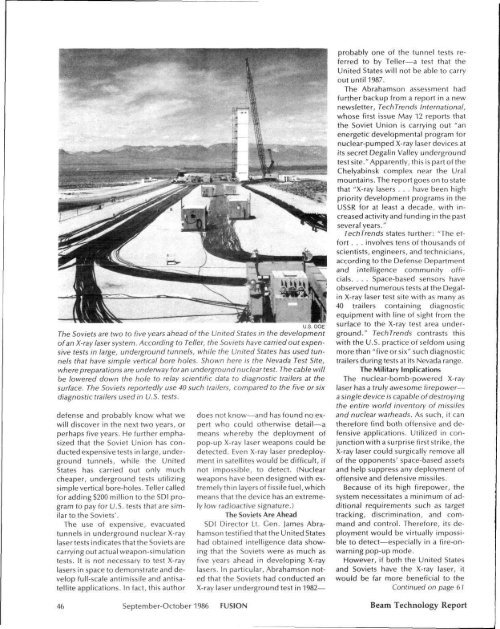Create successful ePaper yourself
Turn your PDF publications into a flip-book with our unique Google optimized e-Paper software.
U.S. DOB<br />
<strong>The</strong> Soviets are two to five years ahead <strong>of</strong> the United States in the development<br />
<strong>of</strong> an X-ray laser system. According to Teller, the Soviets have carried out expensive<br />
tests in large, underground tunnels, while the United States has used tunnels<br />
that have simple vertical bore holes. Shown here is the Nevada Test Site,<br />
where preparations are underway for an underground nuclear test. <strong>The</strong> cable will<br />
be lowered down the hole to relay scientific data to diagnostic trailers at the<br />
surface. <strong>The</strong> Soviets reportedly use 40 such trailers, compared to the five or six<br />
diagnostic trailers used in U.S. tests.<br />
defense and probably know what we<br />
will discover in the next two years, or<br />
perhaps five years. He further emphasized<br />
that the Soviet Union has conducted<br />
expensive tests in large, underground<br />
tunnels, while the United<br />
States has carried out only much<br />
cheaper, underground tests utilizing<br />
simple vertical bore-holes. Teller called<br />
for adding $200 million to the SDI program<br />
to pay for U.S. tests that are similar<br />
to the Soviets'.<br />
<strong>The</strong> use <strong>of</strong> expensive, evacuated<br />
tunnels in underground nuclear X-ray<br />
laser tests indicates that the Soviets are<br />
carrying out actual weapon-simulation<br />
tests. It is not necessary to test X-ray<br />
lasers in space to demonstrate and develop<br />
full-scale antimissile and antisatellite<br />
applications. In fact, this author<br />
does not know—and has found no expert<br />
who could otherwise detail—a<br />
means whereby the deployment <strong>of</strong><br />
pop-up X-ray laser weapons could be<br />
detected. Even X-ray laser predeployment<br />
in satellites would be difficult, if<br />
not impossible, to detect. (Nuclear<br />
weapons have been designed with extremely<br />
thin layers <strong>of</strong> fissile fuel, which<br />
means that the device has an extremely<br />
low radioactive signature.)<br />
<strong>The</strong> Soviets Are Ahead<br />
SDI Director Lt. Gen. James Abrahamson<br />
testified that the United States<br />
had obtained intelligence data showing<br />
that the Soviets were as much as<br />
five years ahead in developing X-ray<br />
lasers. In particular, Abrahamson noted<br />
that the Soviets had conducted an<br />
X-ray laser underground test in 1982—<br />
probably one <strong>of</strong> the tunnel tests referred<br />
to by Teller—a test that the<br />
United States will not be able to carry<br />
out until 1987.<br />
<strong>The</strong> Abrahamson assessment had<br />
further backup from a report in a new<br />
newsletter, TechTrends International,<br />
whose first issue May 12 reports that<br />
the Soviet Union is carrying out "an<br />
energetic developmental program for<br />
nuclear-pumped X-ray laser devices at<br />
its secret Degalin Valley underground<br />
test site." Apparently, this is part <strong>of</strong> the<br />
Chelyabinsk complex near the Ural<br />
mountains. <strong>The</strong> report goes on to state<br />
that "X-ray lasers . . . have been high<br />
priority development programs in the<br />
USSR for at least a decade, with increased<br />
activity and funding in the past<br />
several years."<br />
TechTrends states further: "<strong>The</strong> effort<br />
. . . involves tens <strong>of</strong> thousands <strong>of</strong><br />
scientists, engineers, and technicians,<br />
according to the Defense Department<br />
and intelligence community <strong>of</strong>ficials.<br />
. . . Space-based sensors have<br />
observed numerous tests at the Degalin<br />
X-ray laser test site with as many as<br />
40 trailers containing diagnostic<br />
equipment with line <strong>of</strong> sight from the<br />
surface to the X-ray test area underground."<br />
TechTrends contrasts this<br />
with the U.S. practice <strong>of</strong> seldom using<br />
more than "five or six" such diagnostic<br />
trailers during tests at its Nevada range.<br />
<strong>The</strong> Military Implications<br />
<strong>The</strong> nuclear-bomb-powered X-ray<br />
laser has a truly awesome firepower—<br />
a single device is capable <strong>of</strong> destroying<br />
the entire world inventory <strong>of</strong> missiles<br />
and nuclear warheads. As such, it can<br />
therefore find both <strong>of</strong>fensive and defensive<br />
applications. Utilized in conjunction<br />
with a surprise first strike, the<br />
X-ray laser could surgically remove all<br />
<strong>of</strong> the opponents' space-based assets<br />
and help suppress any deployment <strong>of</strong><br />
<strong>of</strong>fensive and defensive missiles.<br />
Because <strong>of</strong> its high firepower, the<br />
system necessitates a minimum <strong>of</strong> additional<br />
requirements such as target<br />
tracking, discrimination, and command<br />
and control. <strong>The</strong>refore, its deployment<br />
would be virtually impossible<br />
to detect—especially in a fire-onwarning<br />
pop-up mode.<br />
However, if both the United States<br />
and Soviets have the X-ray laser, it<br />
would be far more beneficial to the<br />
Continued on page 6 /<br />
46 September-October 1986 FUSION Beam Technology Report

















